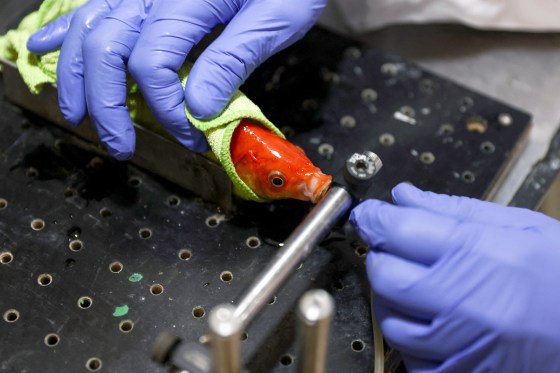
In exchange for fish food, the test subjects were successfully trained to maneuver a “fish-operated vehicle” through obstacles and to a target at the opposite end of a room.
“Do you know how to drive this thing?” asks one of the fish in a tank, according to an ancient joke.
Israeli researchers appear to have discovered the solution.
Using a top-down camera that watches their motions around a tiny fish tank, a team from Ben-Gurion University has successfully taught goldfish to drive a robotic automobile on land.
When a fish swims close to a side of the fish tank, the camera in the “fish-operated vehicle” employs motion detection technology to transmit a signal to one of its four wheels. The fish eventually understood that their motions corresponded to the vehicle’s movements.
The fish were successfully trained to reach a pink target at the opposite end of a room in exchange for a fish food reward, which they were able to achieve repeatedly and even in the face of impediments.

The study, which was published this month in the peer-reviewed journal Behavioral Brain Research, reveals that fish’s navigational abilities remain intact in a land-based context, according to the researchers.
When one species is placed in another’s habitat and performs an otherwise familiar job — in this case navigation — the process is known as domain transfer technique.
And, according to one of the study’s authors, this demonstrates that humans and fish aren’t as unlike as some may believe.
“If you look at the evolutionary tree of evolution, the branch on which we sit and the branch on which fish sit barely separated away 450 million years ago,” said Ronen Segev, a Ben-Gurion University professor who has long researched fish behavior.
“It’s not that fish are primitive; they just evolved in a totally different environment than we do. To survive in their surroundings, they must tackle complex [issues].”

The fish had trouble figuring out how the GPS system worked at first. They “were able to drive the vehicle, explore the new area, and reach the objective regardless of the starting position, all while avoiding dead ends and rectifying location mistakes,” according to the research.
Future research, according to Segev, might investigate if fish can navigate in more difficult situations, such as finding a target they can’t see at first.
The research included six goldfish, the largest of which was just 7 inches long and weighed barely more than 4.2 oz. They were each given ten driving lessons.
Mr. Darcy and Mr. Bingley were two shining stars, according to researcher Sachar Givon, who named the fish after characters from Jane Austen’s “Pride and Prejudice.”
The research might also help shatter the widely held belief that a goldfish’s memory lasts only a few seconds, which has been debunked several times.
